Over the past 20 years or so, the way we cook and eat at home has changed almost completely. We spend far less time in the kitchen, and at the same time, we expect much more from our meals: food that’s ready quickly with layers of flavour and texture, food that does us good from an array of world flavours. There has been nothing short of a revolution when it comes to putting plants at the centre of our plates, and that thrills me. As our eating habits evolve, we want more from a recipe. It must be fast but clear; easy, but brimming with taste.

With this in mind, most of my recipes rely on a few favourite flavour-packed components; a capsule pantry of ingredients that are always in fashion. After much note-taking, recipe-reading and talking to amateur and professional cooks, I landed on the 12 I rely on the most: tahini, miso, peanut butter, lemons, olive oil, vinegar, mustard, tinned tomatoes, capers, chilli, garlic and onions.
All of them add an element of flavour that I love and crave and use, in many cases, almost daily. Here’s a brief guide to how you can too.
Tahini
Tahini the colour of caramel sits on my counter next to the oils and vinegars – it’s used too often to be put away. I could write a love letter. Buttery and sweet with some backup from gentle bitterness, it walks the line between sweet and savoury like nothing else. Whipped with lemon, water and garlic it becomes cloud-like. Toss it through noodles with chilli oil, or bake it into a flapjack or a cake to add a buttery bitterness. It’s the noodles I make the most: tahini and crunchy chilli oil swirled into an instant sauce and tossed with warm egg noodles, then topped with spring onions and cucumber. To me, there is no quicker or better dinner.
Miso
Miso fills a pot with flavour with very little effort. I keep a white shiro miso, a red miso and a deep dark barley miso on the top shelf of my fridge, ready to unleash. Miso is so useful in vegetarian cooking, as it brings a hit of umami that can be hard to get with veg alone. Enjoy in a quick broth with greens and tofu for a five-minute dinner, as a slick under cheese on toast, whisked into cake batter, or stirred through soupy udon. Endless umami.
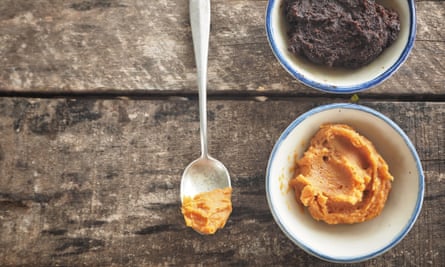
Peanut butter
Peanut butter was part of my childhood and continues to be something I crave. I use it now in cooking, whisked with soy, ginger, chilli and rice vinegar to a sauce somewhere close to satay that I eat with rice. It adds a very good creaminess to tomato soup, as well as a richness to a curry or stews, and a saltiness to cookies and cakes. It’s especially good whenever I’ve used a can of coconut milk. I make a simple tomato soup with onions, garlic, ginger and a couple of tins of tomatoes, plus a can of coconut milk if I have it. Once it’s cooked, I add three generous tablespoons of peanut butter and blitz. The PB brings a moreish richness and depth.
Lemons
For me, lemons are a third seasoning. When a dish is lacking something, I often find that lemon completes it. You can harness so many different flavours from a lemon: the sharp, refreshing acidity from juice; the brightening sherbet of fresh zest; the rounded lift of a roasted lemon, with its sharp but caramelised notes. And then there’s preserved lemon, which brings something altogether different to the table: salty, tangy, full. From quick tarts topped with whole slices of lemon to one-pot pasta al limone, lemons will for ever be where I turn first in the kitchen. I like to slice then finely chop a few thin slices of lemon, skin and all, to toss through salads for zing, or to add at the end to perk up a stew. A couple cut in half and added to a tray of potatoes can be squeezed over once roasted for a mellow, caramel-y lemon freshness.
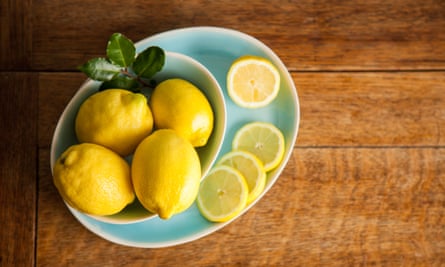
Olive oil
I absolutely couldn’t cook without olive oil. A good olive oil improves almost anything – it’s one of my most-loved and most-used ingredients. I invite you to be brave with it. It adds a huge amount of texture and mouthfeel, not just flavour. Olive oil can be drizzled on to almost anything, including good vanilla ice-cream, or used in cakes for a soft bouncy crumb that never goes dry. My favourite way with olive oil is to fill a pan about 1cm deep, then add a finely sliced bunch of spring onions and cook until they are crisp and just browned before adding a pinch of sugar and some spices (turmeric and chilli). Poured hot over cold yoghurt, this dressing/dip/stuff-of-heaven improves almost anything.
Vinegar
Acid is the most important and forgotten aspect of cooking. That often means vinegar to me. It’s a highlight, a top note that brings a plate of food together. Vinegar is an always available, cheap and easy way to add a hit of acidity – I use cornichons and gherkins too to add a sour kick. My white bean and pickle stew has become a favourite: to fried onion, I add a jar of white beans and a shredded head of kale or cavolo nero, then a good dash of pickle brine and some chopped pickles. Once it’s thick and creamy, I finish with more pickles, dill and creme fraiche.
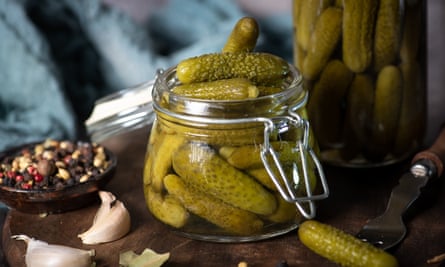
Mustard
A tiny teaspoon of mustard adds an unreasonable amount of flavour. I use it in so much of my cooking. It can be a subtle, warm note or an upfront sit-up-and-pay-attention flavour. Paired with ketchup it’s a joy, and if you add pickle then you are close to perfect. However you use it, it’s such an easy way to get flavour into food quickly, whether you’re perking up an egg mayo sandwich or using the seeds in an aubergine curry. Double mustard potatoes are a favourite, too: boiled potatoes coated in a dressing of dijon and wholegrain mixed with oil and vinegar, plus radishes and celery for crunch, as well as any soft herbs I have.
after newsletter promotion

Tinned tomatoes
I eat fresh tomatoes for most of the year – colourful British ones in the summer and the hardier, saltier Italian and Spanish winter varieties in the winter. But nothing comes close to the ease of a tin or the squeeze of a tube. To my palate, once cooked, they have a perfect balance of acidity and sweetness. The puree brings more deep richness, its edges softened by a minute in the pan. In my kitchen a quick sauce with olive oil and a bashed clove of garlic is used to top simply cooked puy lentils with herbs and creme fraiche to finish, stirred with capers through pasta. Tins become a quick soup.
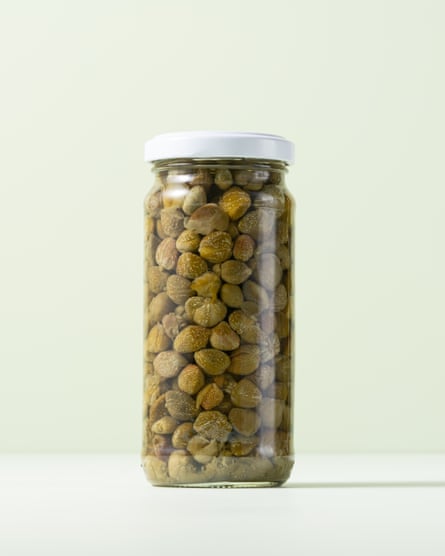
Capers
Capers are a constant in my kitchen. They bring salt, acidity and umami, with a perky, almost mustardy, note. They also ask little of me and sit in my fridge for months. In vegetarian cooking, they create a rounded, savoury base that stands in for the anchovies I choose not to eat. The brine is a gift, to splash over a focaccia before baking, or for using pastas, gratins and caponata. Even chocolate ice-cream is made better by a caper; think about what salt does to caramel and you will have a sense of what capers do to chocolate. At the moment, I love capers most in caper brine margaritas, which I make most weekends.
Chilli
From searing heat to gentle hum, chilli is the warming heart. There are hundreds of types of chilli, but the ones I use most are ancho, chipotle, pasilla, dried chilli flakes, smoked paprika and harissa. Just a spoonful of harissa stirred through yoghurt or into a stew of chickpeas, kale and lemon is transformative cooking. A couple of tablespoons of smoky chipotle in adobo get stirred through the tomato sauce for a wholly inauthentic but much-loved parmigiana.
Garlic
Garlic’s transformative power to make food tasty is almost unfair on the other ingredients in the kitchen. I use garlic sparingly, as an accent, not to overwhelm. Adding a little garlic to your food can sharpen the taste of everything else; adding too much just makes everything taste like garlic. Often, when I’m making tomato sauce, I will bash the clove with the side of the knife and let it sizzle whole and flavour the oil it’s cooking in then lift it out. That hint of garlic is all I need. Confited, it turns into a mellow caramel-y butter that I use in everything from cauliflower cheese to pasta, or just eat on toast.
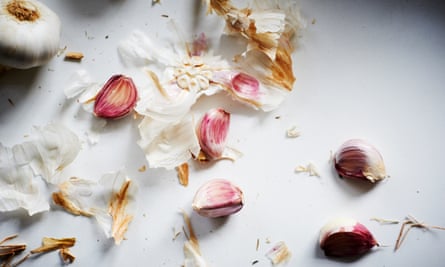
Onion
There is poetry in an onion, a steady assurance of flavour we can rely on. In my kitchen, they are used 100 ways, from slow-cooked and buttery to pickled and punchy; cooked under pastry with cheese and potato or tempered with acid to lift a tomato salad. All that from one papery allium that lives in the dark. Shallots cooked slow with butter, capers and tomato puree form a pantry pasta sauce. Grated and used as a marinade, they soften and flavour gentle paneer for a curry. Roasted with butter, stock and star anise they are whole, finally a vegetable in their own right, and in all their oniony glory.

Comments (…)
Sign in or create your Guardian account to join the discussion